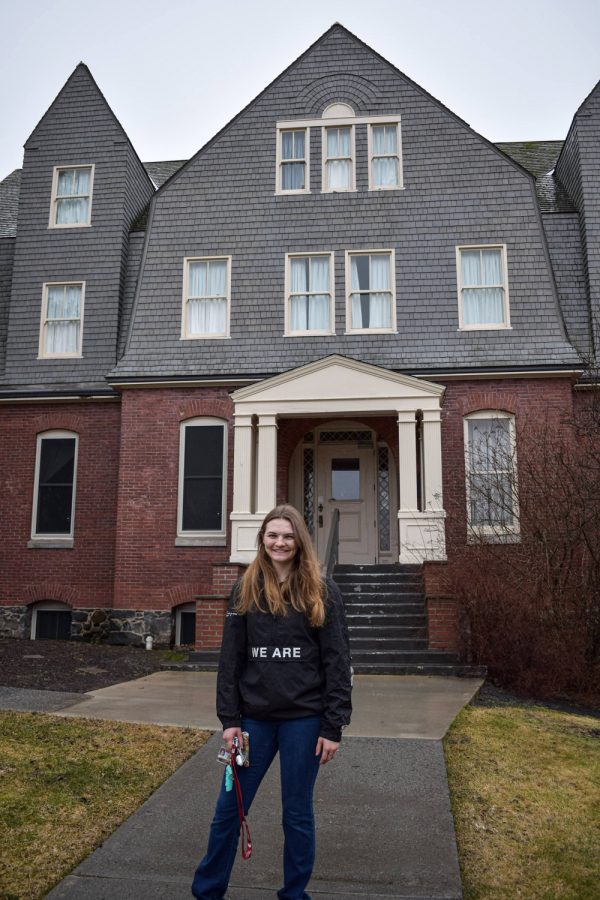Housing, Residence Life discusses dorm closures, plans for Southside
Low enrollment, staff shortages caused closure of four residence halls; potential for new Southside dining hall
Junior mathematics teaching major Jordyn Smith talks about her freshman experience two years ago living in Stevens Hall, March 2.
March 4, 2022
Over the past two years, low student enrollment rates and staff shortages at WSU caused Housing and Residence Life to close four residence halls, eliminating all but one single-gender dorm.
Although Housing and Residence Life will not remodel Stevens, Wilmer Davis and Stimson halls in the near future, its staff hopes to revitalize the south side of campus with new communal spaces starting the summer of 2023, said Brandon Brackett, director of Housing and Residence Life.
Waller Hall is getting renovated to become a multicultural space accessible to students, according to an NWPB article detailing the recent sale of WSU heritage houses.
Brackett said he recommended closing the four residence halls in 2020 after about 700 students returned to campus that year. A decrease in student enrollment caused a decrease in income for the university.
Brackett said he experienced the five most formative years of his life in Stimson Hall and that it was difficult to close that hall in particular.
“It tears my heart up, to be honest,” he said. “I spent five years living in Stimson and loved every second of it. I hate that it’s closed right now, but it’s financially a better decision in terms of what we can do resources-wise to enhance and maintain the students’ experience.”
Jordyn Smith, junior mathematics teaching major, said she chose to live in Stevens Hall her freshman year in 2019 because she wanted a smaller, tight-knit community and thought the dorm’s history was “incredibly cool.”
She said she considers the friends she met that year to be her family.
Smith said she remembers participating in unique hall activities like Sunday tea time. Once they graduated, students who had lived in the dorm left their teacup in the two cases near its entrance, which are filled with the teacups of past students.
Smith said that Stevens Hall, the oldest dorm on campus, serves as a nice memory of how WSU first began, and she was disappointed when it closed.
“[I was] kind of heartbroken, I’m not going to lie,” Smith said. “This was actually my favorite building on campus, so seeing nobody living in it was kind of sad because I’ve had so many great memories here, and it’s sad to see that other people won’t. This one’s kind of near and dear to my heart.”
If WSU were to keep all of the dorms open, the quality of maintenance and custodial service would be very low, Brackett said.
Aaron Cunningham, Auxiliary Facility Services director, said the turnover and vacancy rate of maintenance staff is about 20% compared to about 10% in the past.
Housing and Residence Life employs 103 people to provide preventative maintenance for the closed residence halls and complete three projects per year for the open halls, like repairing roofs and sidewalks, he said.
Brackett said reopening the residence halls would be an expensive undertaking, considering they have never been remodeled with the exception of Stimson Hall, which was remodeled in the 1980s.
Housing and Residence Life began to completely remodel Wilmer Davis Hall two weeks before the pandemic struck Pullman, but increasing labor and supply costs have placed that project on the back burner, he said.
Although no plans are finalized, the university also plans on updating Southside starting the summer of 2023 to improve its community feel, Brackett said.
Cunningham said Southside is a “gateway” to campus and would benefit from a common gathering space that has a “destination feel,” where students can stay and socialize rather than take their food to go, he said.
He said the intersection of Nevada Street and Stadium Way is one of the busiest pedestrian areas on campus, so constructing a new dining hall would positively impact the students living in that area.
“A dining center, at least to start with, is a better way to spend the kind of money we’re talking about because it takes tens of millions of dollars and several years to get something like that,” Cunningham said. “We have to look at it as making the most impact for the most folks.”
Cunningham said he is the “division’s pessimist” and suspects there may be some design or infrastructure delays before the university is able to break ground on the project.
The funding for this project would come from the university’s reserves as well as “bonding” with local organizations, he said.
Once Southside is modernized over the course of several years, Brackett said he would like Housing and Residence Life to “come back to the hill” for renovations because that is where WSU originated.
Throughout his career, Brackett said he hopes to produce an experience for students that is similar to the one he had in Stimson Hall.
“It’s a big reason that I went into the work I went into,” Brackett said. “I wanted to recreate those experiences for the students that we have now. I look back and see how much I grew as an adult in those years … At the bare minimum, that’s my goal: to allow students to have that same opportunity to grow, develop and mature.”


















